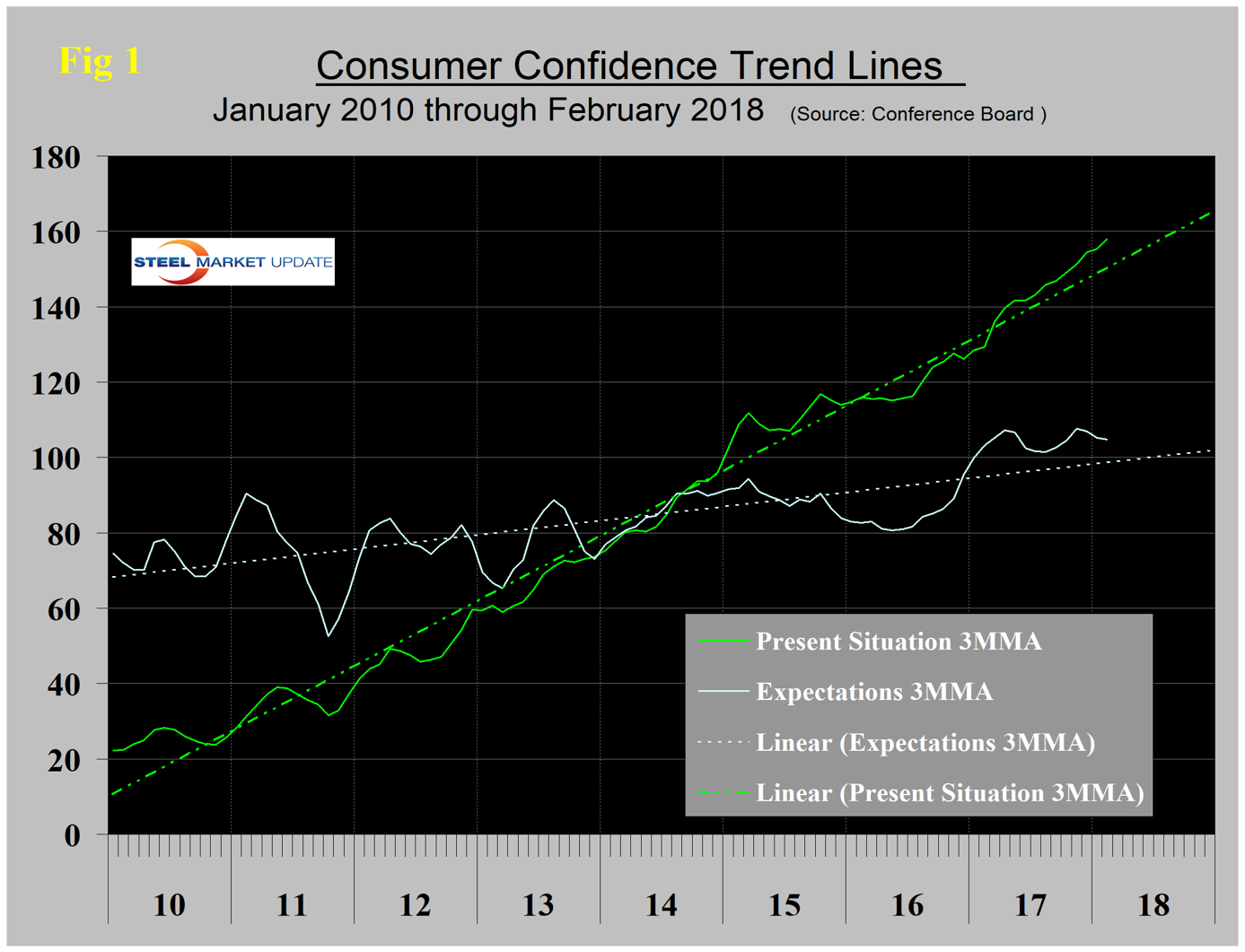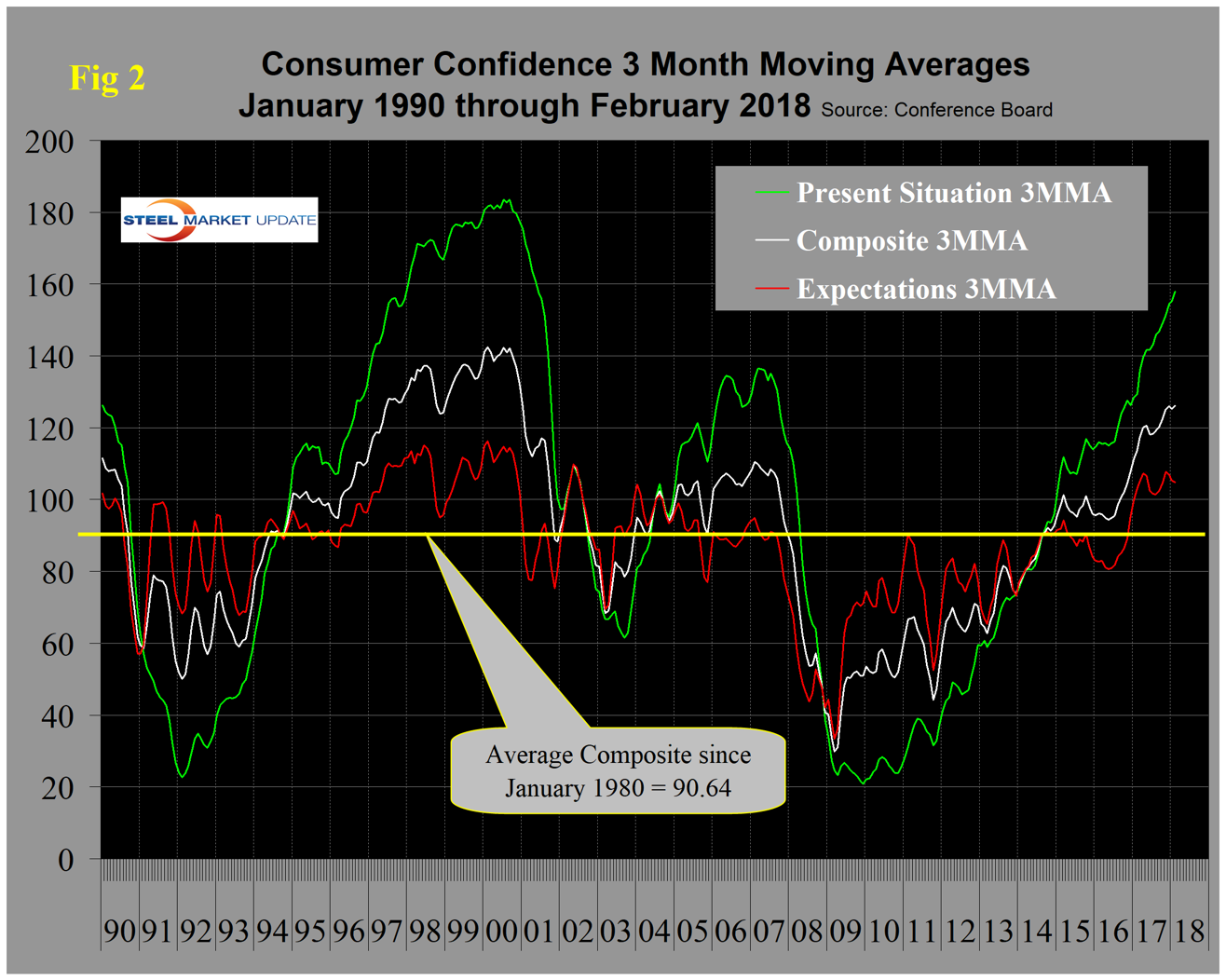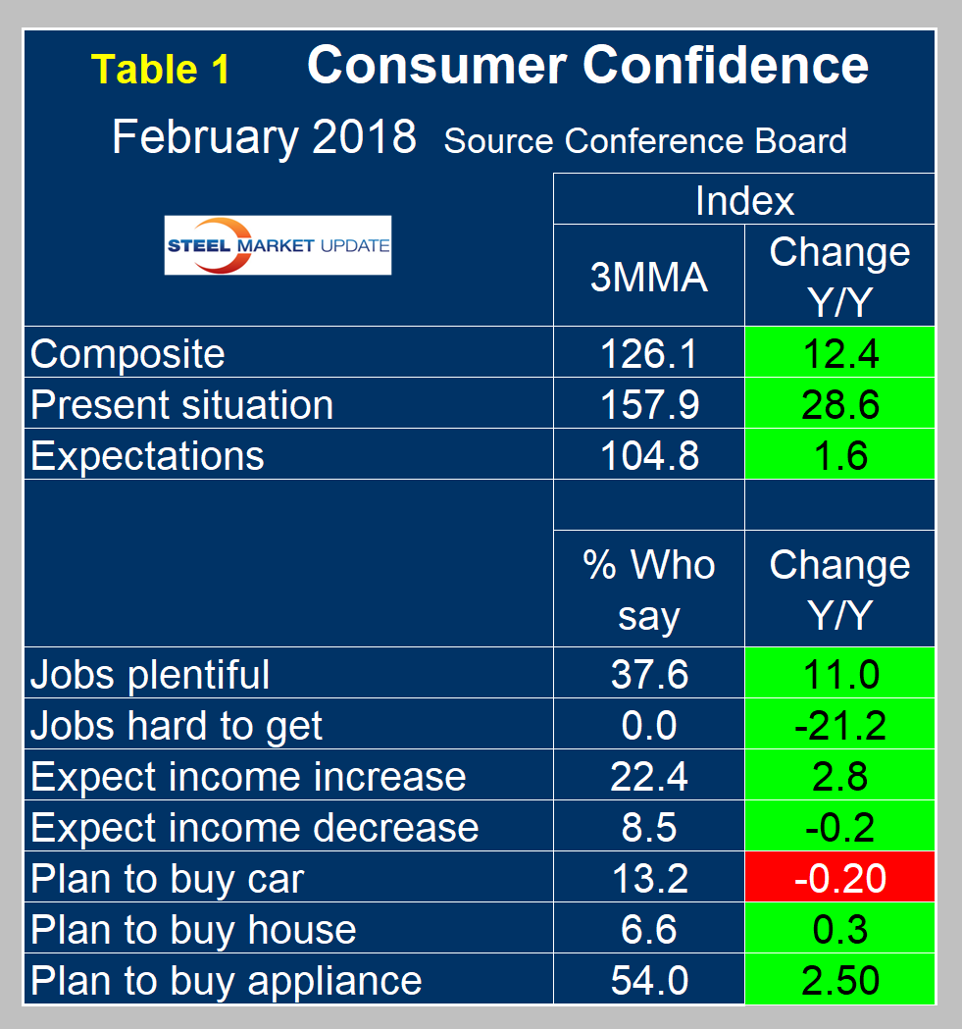Economy

Consumer Confidence Surges in February
Written by Peter Wright
January 30, 2018
Consumer confidence dipped slightly in December, recovered partially in January and surged in February to the highest level since November 2000, according to The Conference Board’s February Consumer Confidence Survey. The composite value of consumer confidence in February was 130.8, up from 124.3 in January (1985=100). The three-month moving average (3MMA) increased from 125.3 in January to 126.1 in February, which was 12.4 points higher than in February last year. Consumer confidence is a driver of consumer spending, which is the largest component of GDP and ultimately drives a large portion of steel consumption.
In February, the 3MMA of the composite increased by 0.73 points to 126.1 points. We prefer to smooth the data with a moving average because of monthly volatility, which in the case of consumer confidence has been quite extreme since the beginning of 2016. The composite index is made up of two sub-indexes. These are the consumer’s view of the present situation and his or her expectations for the future. Both are now above their nine-year trend line (Figure 1).

The historical pattern of the 3MMA of the composite, the view of the present situation and expectations since January 1990 are shown in Figure 2.

All three measures are now higher than they were at the pre-recession peak of 2007. The 3MMA of both components of the composite surged from mid-2016 until June 2017 when expectations briefly declined. The consumer’s view of the present situation continued to surge through February as expectations have been relatively unchanged for the last year. Comparing February 2018 with February 2017, the 3MMA of the composite was up by 12.4, the present situation was up by 28.6 and expectations were up by 1.6 (Table 1). All sub-indexes in Table 1 were green in November through January, but plans to buy a car declined year over year in February.

The consumer confidence report includes encouraging data on job availability and wage expectations. It reports on the proportion of people who find that jobs are hard to get and those who believe jobs are plentiful, and it measures those who expect a wage increase or a decrease. Since February 2011, both the employment components have steadily improved. The difference between those finding jobs plentiful and hard to get has been over 20 percent in the last four months and in February 2018 stood at 24.7 percent. Expectations for wage increases have been less consistent, but the differential between those expecting an increase and those expecting a decrease has been in positive double digits since January 2017. Plans to buy an automobile had a negative year over year shift for the first time since October. Plans to buy a house have been positive year over year for each of the last 11 months. Apart from a slight decline last October, plans to buy an appliance have had positive year-over-year growth since August 2016.
Economy.com summarized as follows: “Consumer confidence jumped in February, improving by 6.5 points, its strongest one-month gain in almost a year. Confidence now sits at 130.8, reaching a post-2000 high. This month’s report showed solid improvement in present situations and in economic expectations. Consumers were more pleased with the job market, and businesses reported good business conditions. Labor, income and business expectations followed suit. Purchase plans recovered somewhat, with home buying and appliance purchasing plans rebounding. However auto purchasing plans reverted to their lowest level since September. Inflation expectations rose by 0.1 point, with 12-month inflation expected to average 4.7 percent.”
“Consumer confidence improved to its highest level since 2000 (November 2000, 132.6) after a modest increase in January,” said Lynn Franco, Director of Economic Indicators at The Conference Board. “Consumers’ assessment of current conditions was more favorable this month, with the labor force the main driver. Despite the recent stock market volatility, consumers expressed greater optimism about short-term prospects for business and labor market conditions, as well as their financial prospects. Overall, consumers remain quite confident that the economy will continue expanding at a strong pace in the months ahead.”
Consumers’ appraisal of present-day conditions improved in February, according to The Conference Board survey. Consumers’ assessment of business conditions was moderately more positive than in January. The percentage saying business conditions are “good” increased slightly from 35.0 percent to 35.8 percent, while those saying business conditions are “bad” decreased from 13.0 percent to 10.8 percent. Consumers’ assessment of the labor market was considerably more favorable. Those claiming jobs are “plentiful” increased from 37.2 percent to 39.4 percent, while those claiming jobs are “hard to get” decreased from 16.3 percent to 14.7 percent. Consumers were also more optimistic about the short-term outlook in February. The percentage of consumers anticipating business conditions will improve over the next six months increased from 21.5 percent to 25.8 percent, while those expecting business conditions will worsen decreased from 9.8 percent to 9.4 percent. Consumers’ outlook for the job market was also more positive. The proportion expecting more jobs in the months ahead increased from 18.7 percent to 21.6 percent, while those anticipating fewer jobs declined from 12.5 percent to 11.9 percent. Regarding their short-term income prospects, the percentage of consumers expecting an improvement increased from 20.6 percent to 23.8 percent, However, the proportion expecting a decrease also rose, from 7.9 percent to 8.6 percent.
SMU Comment: Steel demand is dependent on the growth of GDP, which in turn is strongly influenced by consumer confidence and disposable income. The current consumer confidence report is excellent in both these respects.

Peter Wright
Read more from Peter WrightLatest in Economy

Steel groups welcome passage of budget bill
Steel trade groups praised the passage of the Big Beautiful Bill (BBB) in Congress on Thursday.

Industry groups praise Senate for passing tax and budget bill
The Steel Manufacturers Association and the American Iron and Steel Institute applauded the tax provisions included in the Senate's tax and budget reconciliation bill.

Chicago PMI dips 0.1 points in June
The Chicago Purchasing Managers Index (PMI) slipped 0.1 points to 40.4 points, in June.

Multi-family pullback drives housing starts to 5-year low in May
US housing starts tumbled in May to a five-year low, according to figures recently released by the US Census Bureau.

Architecture firms still struggling, ABI data shows
Architecture firms reported a modest improvement in billings through May, yet business conditions remained soft, according to the latest Architecture Billings Index (ABI) release from the American Institute of Architects (AIA) and Deltek.
